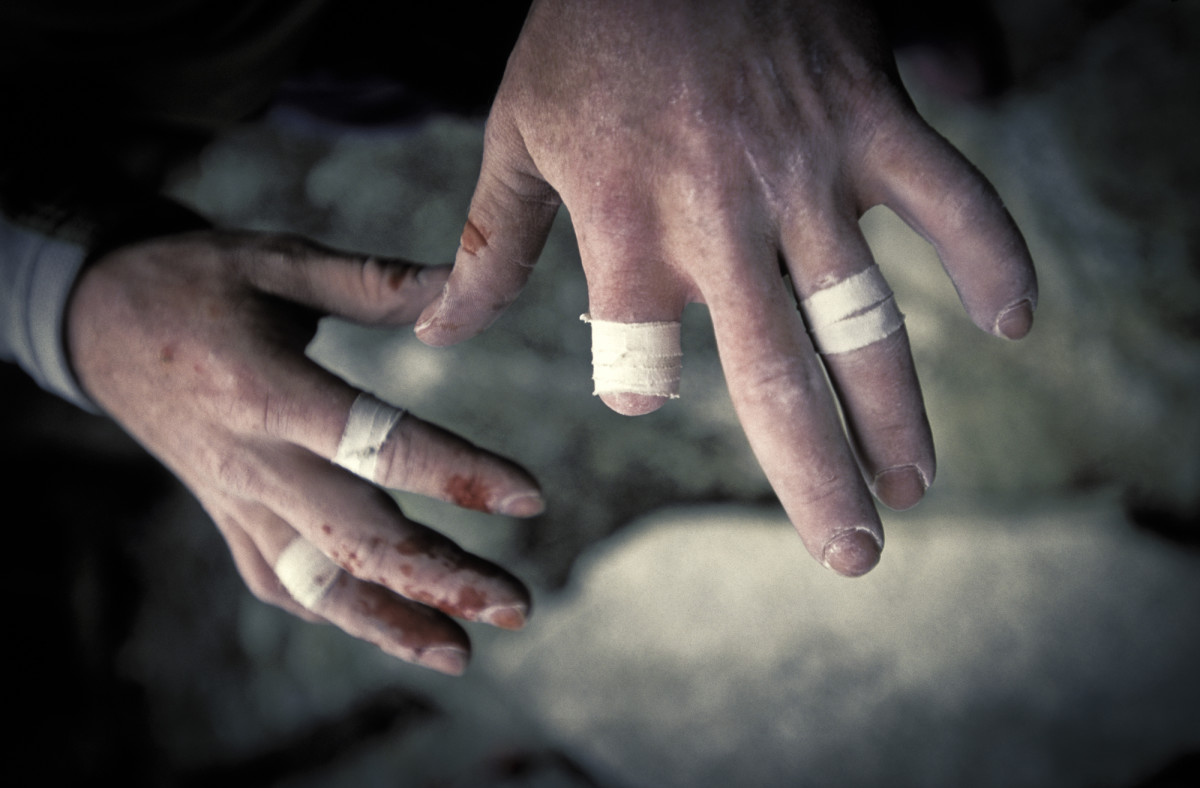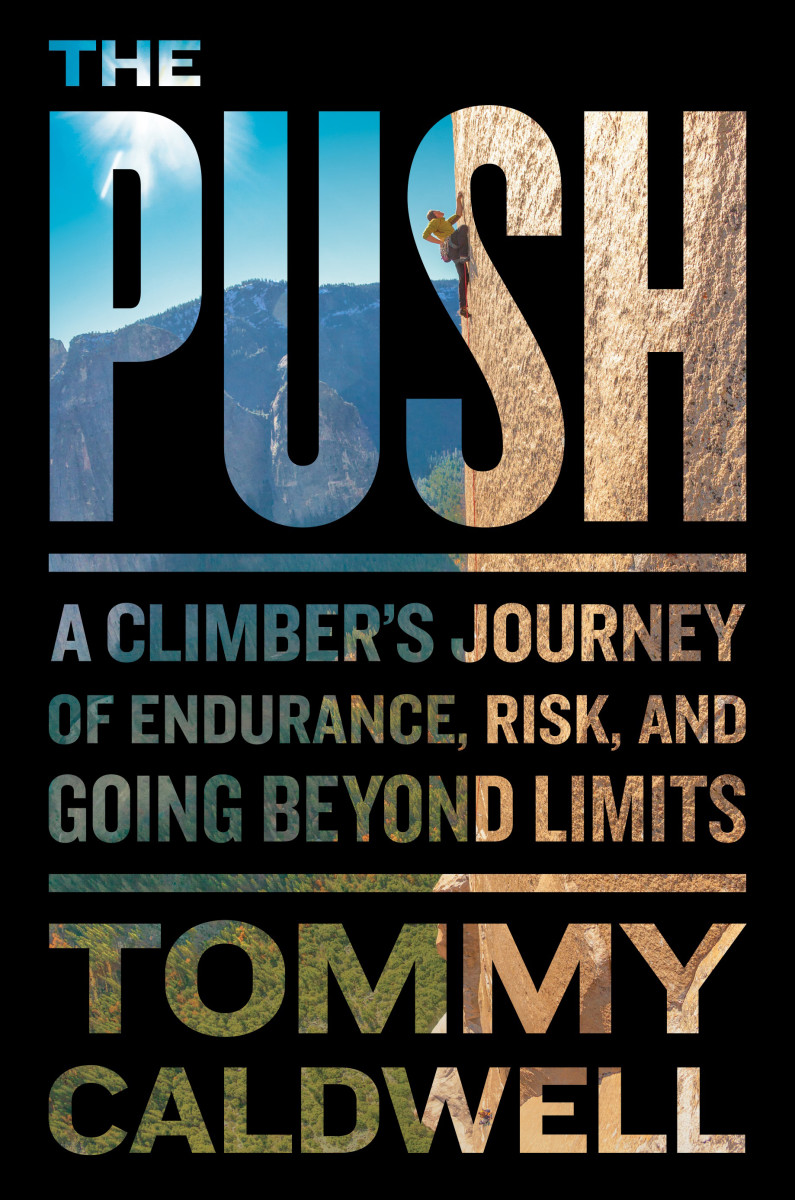How rock climber Tommy Caldwell re-learned his craft after sawing off his finger

The following is excerpted from THE PUSH: A Climber’s Journey of Endurance, Risk, and Going Beyond the Limits by Tommy Caldwell, published on May 16, 2017 by Viking, an imprint of Penguin Publishing Group, a division of Penguin Random House, LLC. Copyright © 2017 by Tommy Caldwell.
One day, I was building a platform for our new washer and dryer. The cracked and slanted concrete floor needed to be shimmed to make it flat. Instead of buying shims I decided I could make some by ripping two-by-fours with the table saw. I gathered a handful of one-foot lengths and headed outside.
As I fed the pieces lengthwise, a two-by-four shot from the table into the hillside like an arrow. I switched off the saw and noticed a few drops of liquid on the table’s black surface. I raised my left hand. Blood burbled up from the stump of a finger like water from a leaky drinking fountain. I saw the white bony stub of my index finger, the lower joint above the knuckle, some jagged flesh, and what must have been a tendon or ligament.
Panic flooded my mind: How can I climb without a left index finger?
Buy Now

The Push
by Tommy Caldwell
The first person to free climb the Dawn Wall of Yosemite's El Capitan details a climber's journey of endurance, risk, and going beyond limits.
I started to feel faint, my vision swam for an instant, but I blinked and took in a deep breath. I had to find it. I scanned the saw table, scrambled around the side, careful to keep my hand above my heart while searching the ground. Not wanting to distress Beth, I turned toward the house and called to her, voice steady, “I just chopped off my finger. Please come out here.”
Beth came running and found my finger lying beside the saw. She snatched it out of the pile of sawdust and rushed inside. I stood confused, shocked. She returned in a flash with a Ziploc baggie, the severed part of my finger floating in water. Then Beth sped our little Honda to the hospital in Estes Park. The doctor was calm. We weren’t. He injected Novocain into the nub. Then he packed the finger in ice and sent us to the big hospital in Fort Collins.
No matter how fast she drove, she couldn’t outrace my anxiety.
Tears streamed down my face. I thought about the glistening granite of Yosemite. Would I ever again be able to do the thing that I love most, the thing that both drives me and brings me peace? I felt exposed. I had no backup plan, no skills, no dreams beyond those that climbing provided. Would Beth still love me if we no longer had the connection that had brought us together in the first place?
When athletes beat the odds: These six stars are just getting better age
In the next two weeks, between the accident and three surgeries, I lost nearly a third of my blood volume. I spent my days lying motionless in a sterile hospital room, connected to a morphine pump that I pushed endlessly, even though I knew it would only send the allowable dose. I wanted the drug more to numb the psychological trauma than for the physical pain.
I had likely just ended my climbing life.
My doctors reattached the finger by pinning the bone and patching together the nerves. Then they tried to sew together the tiny veins, an exceptionally delicate task. The finger kept congesting with blood. To relieve the pressure they re- moved the fingernail, cut and drained my finger through the nail bed, and applied medicinal leeches. They had to relieve the pressure so often that I bled profusely, resulting in more transfusions. They did everything they could as I drifted in and out of consciousness.

When I was awake, my emotions fluctuated from severe anguish to numb acceptance. During the day, when friends and family were around, I felt very loved. My father volunteered to donate his finger for a transplant. I lay there humbled and awed by the lengths he was willing to go for me.
He wasn’t alone in expressing his support and concern and love. Everyone in my family asked countless questions and urged my doctors to do their very best for me. And, of course, Beth remained steadfast in every possible way. She would lie in bed with me, stroking my hair and telling me how much she loved me. She spent nearly as much time in that hospital room as I did.
Still there were those nights, those doubts, the wondering if I was letting Beth down and ending my father’s dreams for me. I couldn’t wait for sleep to overtake me, to ease the pressure of the expectations and obligations that I imposed on myself.
Two days after removing the faltering reattached length of my finger, the doctors sent me home. The index finger on my dominant left hand was now a throbbing stump, two-thirds of it missing. The skin was stitched around the bone, edges protruding like a tiny calzone. Looking at it nauseated me.
Beth set about finding me the best physical therapist. To mitigate the risk of an overly sensitive stump I needed to condition the nerves. “Basically, beat the hell out of it,” the therapist said. She gave me a set of nerve retraining and desensitizing exercises and told me to do them each day for an hour. I did three. One was to reaccustom me to temperature. Hot water, cold water, repeat. Then texture, running my finger through different substances. First rice, then lentils, then dry macaroni, then sharp star-shaped pasta. Next up: dexterity. We’d dump a jar of pennies on the carpet and I had to pick them up one by one with my nub and thumb or other digit. I focused on every penny, not quitting until my brain synchronized the nerves and muscles to perform these fine movements with my new and different finger.

Beth drew up a schedule and directed my training, But the most powerful support she offered was her belief in me. Never for a second did she doubt my ability to recover. She would look me straight in the eye and say with tearful but stern conviction, “You are going to do this.”
In time, I realized my mind was the only thing holding me back. Not long after my release, I started training again. My dad welded up a finger- strengthening machine and I used it constantly. I did pinch-strength training by gripping stacked weight plates. I went for runs in the snow, figuring extra blood flow would enhance the healing. My energy soared. I felt my power returning.
For a long time I dropped things, mostly smaller items like car keys. I also suffered from phantom pains. The tip of my finger itched even though it wasn’t there. Weird things would happen, like I’d get in an elevator and someone else would enter.
How to take your workout outdoors: Escape to Sun Valley for a mountain biking adventure
“Which floor?” I’d ask. “Four.”
I’d reach out, press four, and wait for the elevator to move. Nothing. The person would stare at me. I’d return a polite smile. He’d raise his eyebrows. Smile. Shit! It would hit me. Two inches short of the button, half a phantom finger.
When I started climbing again, I felt a surprising amount of exhilaration. My focus and direction were crystal clear. I realized that it wouldn’t help to dwell on what went wrong. I told myself that pain is growth. That the trauma would enhance my focus. I assumed that no one outside of my family truly expected me to make a full comeback, an idea I found strangely liberating.
